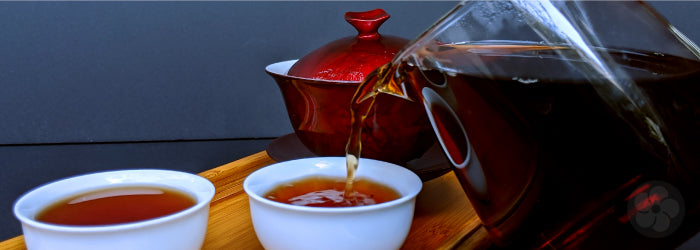Types of Pu-erh Tea: Accelerating Natural Fermentation

When talking about pu-erh teas, we often discuss the difference between sheng teas, which ferment naturally during the aging process, and shou teas, which undergo accelerated fermentation to create a final product in much less time. Distinguishing between these two subcategories can make the overwhelming variety of pu-erh much easier to navigate, since the two types of fermentation can create distinct differences in flavor, mouthfeel, and even caffeine content.
Find out more about the difference between sheng and shou pu-erh teas >>
But this dichotomy can also be misleading, because there are many factors that influence the speed of fermentation beyond the conventional shou processing techniques. The natural fermentation that occurs with age can be affected by methods of initial processing as the fresh leaves are made into maocha, and by the climate and environment the tea is stored in during the aging process. Together, these factors create a full spectrum between the traditional opposites of sheng and shou teas.
Watch Alice explain the basics of pu-erh in this video:
Processing Methods
Seasoned pu-erh drinkers are probably familiar with the methods used to accelerate fermentation when making shou pu-erh teas. Raw maocha, which has been wilted and partially dried, is heaped into large piles with a ‘starter’ culture (usually a previous batch of properly fermented tea) where the natural buildup of heat and moisture creates rapid fermentation. In practice, this process looks much like composting, and the flavors it creates are distinctly rich and earthy. Proper hygiene and management are essential in maintaining the quality of the tea, since the speed of the process leaves little room for correction.
Find out why some shou pu-erh teas taste fishy >>
Even sheng pu-erhs, though, can get a jump start on fermentation during the initial steps of processing. Older teas, especially those made by small producers, were often made with very basic equipment. To wither the fresh tea leaves during the production of maocha, the most traditional method simply involves spreading the leaves on a tarp in the open air. To protect the valuable tea from contamination, the leaves might be covered with another tarp, especially overnight. This practice traps heat, just as the piling of shou pu-erh does, and ultimately gives the tea a head start on fermentation, resulting in a style that is sometimes called ‘semi-cooked’.
The way the leaves are packaged for storage can also have an effect on the way the tea ages. While compressed cakes of pu-erh tea were traditionally favored for their small footprint for transport and storage, loose leaf pu-erhs are becoming more popular today, especially among casual drinkers. Leaves that are not compressed allow for more airflow and circulation, and therefore tend to change and ferment a bit more quickly.
Learn more about the difference between pressed and loose leaf pu-erhs >>
Storage Conditions
Despite all the variables in the initial crafting process, storage and aging are where the category of pu-erh develops real variety. In Hong Kong, where aged pu-erh first became popular, the hot, humid climate served to create the first sheng teas, essentially by accident. Immigrants from Yunnan, importing their favorite pu-erh teas from their dry, inland homeland, found that long term storage transformed the pressed cakes into dark, rich, fully fermented teas. As this style became more popular, some pu-erh dealers even developed ‘wet storage’ methods, which involve introducing extra moisture to speed up the long process of natural fermentation.
Today, with the worldwide popularity of fermented teas, drier storage climates have been found to slow fermentation, creating crisp, fruity flavor profiles, or even halt it altogether, leaving the pu-erh green in color and brash in flavor. Connoisseurs pay close attention to the temperature and humidity of their pu-erh storage containers, even going so far as to create custom ‘pumidors’ that allow for granular control. Anecdotal experimentation shows that two pu-erh teas from the same lot of leaves, stored in different environments, can result in dramatically different final products after long term aging.
Find out how storage climates change pu-erh flavor >>
Ultimately, while the distinction between sheng and shou pu-erhs is helpful, it is also reductive, and in some ways, limiting. While the purposeful acceleration of shou teas creates a clear definition for the most rapidly fermented teas, there is a huge range of fermentation speeds that fall under the umbrella of sheng pu-erhs. From the unfermented ‘green’ styles that are currently popular to the more traditional wet-stored and ‘semi-cooked’ varieties, the dramatic distinctions are part of what make this category so fun to explore!
What characteristics do you appreciate in your favorite pu-erhs? Let us know what you think in the comments below!
Sign up for our newsletter to get blog updates in your inbox!





Comments on this post (0)